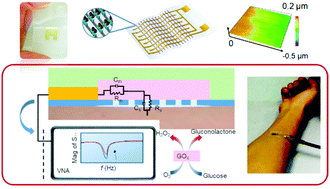Nanostrip flexible microwave enzymatic biosensor for noninvasive epidermal glucose sensing†
Abstract
Microwave sensors based on microstrip antennas are promising as wearable devices because of their flexibility and wireless communication compatibility. However, their sensitivity is limited due to the reduced sensor size and the potential of biochemical monitoring needs to be explored. In this work, we present a new concept to enhance the microwave signals using nanostrip-based metamaterials. The introduction of the nanostrip structures was achieved by theory and simulations. Experiments prove their enhancement of the electric field and sensing response in the characteristic gigahertz (GHz) wave band. Ordered nanostrips were fabricated on a plastic substrate through a simple nanoscale printing approach. Glucose oxidase is directly doped into the nanostrips, which enables a flexible wearable enzymatic biosensor for glucose sensing. Sensing experiments demonstrated that the nanostrip biosensor gives excellent performance for glucose detection, including high sensitivity, fast response, low detection limit, high affinity, and low power consumption. The applicability of the nanostrip-based sensor as a wearable epidermal device for real-time noninvasive monitoring of glucose in sweat is verified as well.

- This article is part of the themed collection: Horizons Community Board Collection: Biosensors


 Please wait while we load your content...
Please wait while we load your content...